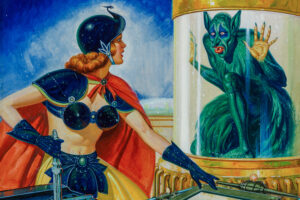
(Copyright 2008 Karl Tate)
Remembering a consummate collector of the ‘nasty’ art of the American pulp magazines.
If there is ever a Hall of Fame for all-time collectors, Robert “Bob” Lesser is sure to be among such legendary acquisitionists as Malcolm Forbes and Phillip Perlman. He has done more to raise the consciousness of the public regarding the importance and significance of mass media art than anyone I know.
The greatest exhibition of Disney animation art, which took place at the Whitney Museum in 1981, owed much to the pieces lent from Bob Lesser’s personal collection, and perhaps more revealing was his involvement behind the scenes in combating the elitist mentality of the “fine arts” community.
In December 1987, Lesser sold his massive collection of comic-art memorabilia for somewhere in the neighborhood of $1 million to Madison Avenue art and collectibles dealer Alexander Acevedo. That collection represented over 23 years of dedicated and serious collecting, as well as research into behind-the-scenes stories of the history of mass merchandising the greatest icons of popular culture.
Fanzine flashback
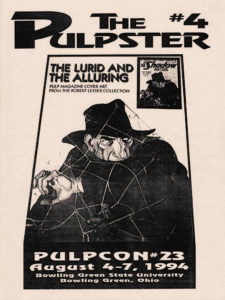
This article originally appeared in The Pulpster (No. 4; August 1994). It has been slightly edited as it appears here.
Editor’s note
Robert Lesser died March 1, 2020, at 96. In 1997, his book Pulp Art: Original Cover Paintings for the Great American Pulp Magazines was published, featuring many of the paintings from his pulp-art collection.
His 1975 book, A Celebration of Comic Art and Memorabilia (Hawthorn Books), beautifully documents that collection. With a print run of only 4,400, today the book itself is a rare item and much sought after. The dedication on the table of contents page offers a revealing insight into the rationale driving Lesser’s interest in popular culture artifacts. It consists of a single quote by artist Claes Oldenberg: “I am for art that does something other than sit on its ass in a museum.”
Lesser was one of the first serious collectors of fountain pens and comic-related watches. As one of the pioneers and most aggressive collectors of toy robots and space toys, he has drawn the attention and respect of such collecting mavens as Ralph and Terry Kovel. He retains the robot collection to this day, although acquisitions are few and far between. You see, he has just about everything ever manufactured in this area! [Lesser sold his robot and space-toy collection in 2008. – ed.]
Time and time again, Lesser has been “ahead of the curve” in pop-culture collecting. Some even say he helped create the curves: arranging exhibitions, promoting articles in major publications, and manipulating interest and prices upward.
Lesser is a complex guy. With a Bachelor and Master of Arts in English from the University of Chicago, he’s an accomplished playwright and denizen of the New York theater community.
Out of college, he drifted into the graphic arts, designing outdoor advertising. Combining that talent with his skill as a consummate salesman, he founded the Robert Lesser Corp., capturing national accounts of Fortune 400 companies. It is in that incarnation that Lesser earned the means to support his prodigious collecting habit.
While others may turn to gambling for kicks, Lesser thrives on the pulse of the auction houses, the thrill of the hunt, and conquest through negotiation.
Writing this takes me back 20 years, to the summer of 1974. Art and collectibles dealer Joe Parente brought a friend along to south Jersey one hot afternoon to examine a rather respectable collection of Sunday funnies, from the very first Hogan’s Alley (Yellow Kid) to the early 1930s, which I had unearthed at a local flea market.
With great pride (and naive hubris), I showed this stranger, clad in bright tropical shirt and straw fedora, the very first Flash Gordon/Jungle Jim Sunday section by the great Alex Raymond.
The stranger laughed, not in a cruel way, but jovially with warmth and irony. I asked what was so funny, and he modestly explained that he had recently purchased the original pen-and-ink rendering of that very same comic section. Talk about one-upmanship!
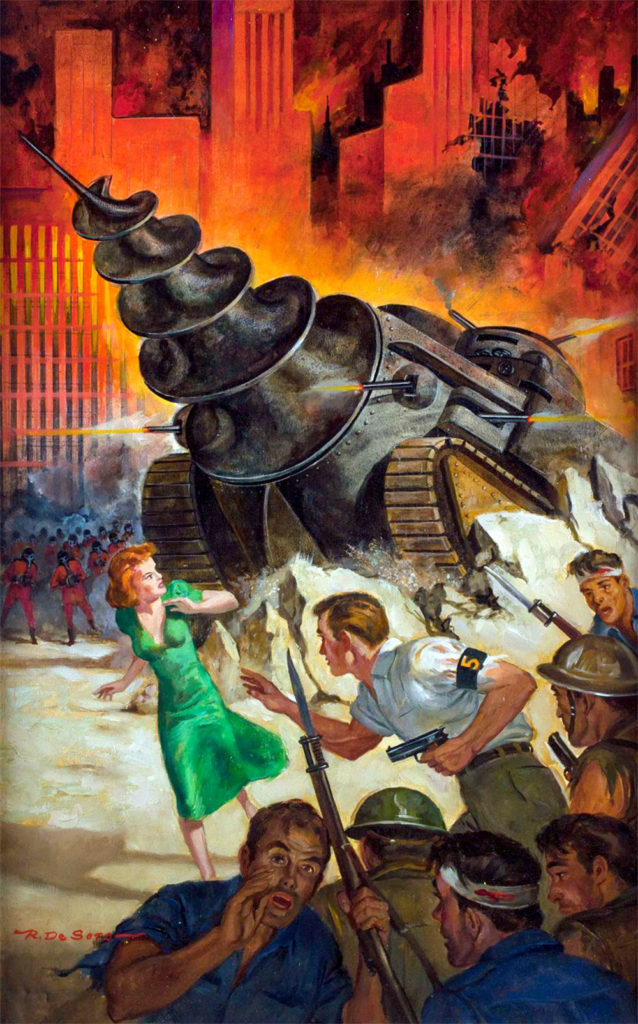
That began my acquaintance with Bob Lesser.
Over the years, we’ve talked often, picking each other’s brains, sharing news of the collecting scene, and forging a lasting friendship.
Like all true collectors. Lesser is driven by insatiable curiosity, and after the sale of his cartoon memorabilia collection, he needed a focus for his acquisitive energies. His love of popular nostalgia, and a deep-rooted understanding and appreciation of art led him to the pulps.
Now he has amassed the single best collection of pulp cover paintings in the country. The collection as of this writing [1994 – ed.] consists of 117 paintings. Only four are reproductions, and one of those is a recreation done by the late, great Rafael DeSoto, for Rafael’s own personal enjoyment.
DeSoto, in case you don’t know, was one of the most prolific and beloved of the pulp artists.
The rest of Lesser’s paintings are the original illustrations done by classically trained artists who created images to capture the eyes and imaginations of millions of Americans, week after week, year after year. Each painting has been professionally restored, and framed with a copy of the magazine whose cover it graced.
While nurturing the collection over the past seven years, Lesser decided to preserve it intact, in order to ensure its availability for both academic study and the continued appreciation of an artform that offers a window into a cultural phenomenon unequaled by TV or movies.
For this interview, I visited Lesser in his NYC apartment — a veritable shrine to the best of collectibles — to put forth some questions, and give him a chance to pontificate, sound off, and share his insight into what pulp cover art will tell future generations about the American psyche of the first half of the 20th century.
Not ‘fine’ art, not ‘nice’ art
Greene: Bob, tell us why you selected pulp art as something worthy of collecting. Why not Norman Rockwells or Robert Maplethorpes?
Lesser: My basic point of view for some time has been that pulp art from 1920 to approximately 1950 is a unique, unusual, and important genre of American illustration/American art. It is different from everything else. It is not “fine” art. It is not “nice” illustration. Why I collect it is, I guess to a large extent, because of its impact. I consider the best of American pulp art — particularly of the 1930s — “American Nightmare Art.”
Each of these paintings is a nightmare. Good is against evil, and the victim is caught in between. And the outcome — the denouement in this drama — is not arrived at. Only, of course, if you bought the magazine for 10 cents would you find out how it ended. And within it, a greater declaration of the characters.
Greene: So, your focus is more on those paintings that, by today’s standards, are more outrageous or violent?
Lesser: By their standards, they were outrageous because they incorporated sex, violence, torture, the victimization of women. The best of the pulp art is the worst, the real down-and-dirty stuff, particularly as painted by John Newton Howitt, who remains beyond my grasp.
Greene: I want to stay with this for a second. It seems that today there is a feeling that those were simpler times, purer, lots more innocent times. And that today we’re more inundated with violence on television and in the movies. Does this art reveal something forgotten about past decades?
Lesser: Absolutely! Each generation as it grows older becomes more conservative. It remembers only the good things of the 1930s and the ’40s. The mind in its state of denial denies any pain. The domination of the middle class in every country is basically around one four-letter word: nice. We forget the nasty. We put out of our minds the horrors of war, persecution, bad times, hunger, crime, all of this. And we say, “Oh, how glorious the past was!” It never was! Ask somebody who was there at the time.
Each generation has its trials. Each generation bears its own cross. As it grows older, it tries to forget.
What these pulp paintings, to a large extent, show is exactly how those times were. There were women being tortured and killed. Yes, there were gangsters. Yes, there were cowboys shooting each other. We had crimes as heinous then as we have crime now.
Greene: How have your acquaintances in the “fine art” community reacted to your collection?
Lesser: What reaction?! They won’t even look at it. They won’t even come here. They slam down the phone and say, “That’s illustration, and there’s no money in it!” or, I get the acronym MEGO — My Eyes Glaze Over. There is no interest whatsoever.
You have to remember, they exist in the world, as you put the question, of “fine” art — nice art. This is not nice art. Fine art can be hung behind your mother-in-law’s new couch. She won’t object. Hang a pulp painting, and the real-estate agent who’s about to sell your house will say, “Get rid of those paintings. I can’t sell your house with that horrible stuff in there.” That’s what happened to my friend Walker Martin.
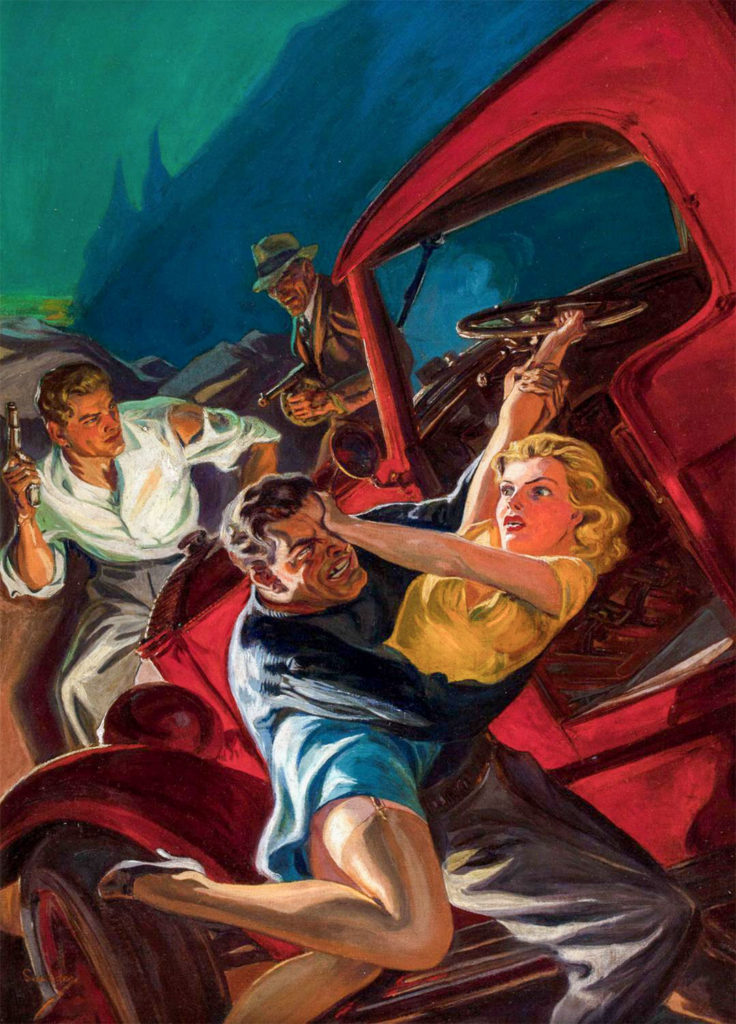
Or, as happened to another collector, “I’m trying to raise two teenage daughters. I’m their mother. I will not have this painting in my house. Sell it to that weirdo in New York.” And that’s how I got my Clues Detective.
This art is definitely anti-middle class. They don’t like this stuff. It’s not nice!
Greene: But there’s always been a part of the fine art establishment that does look for the outrageous. I’m talking about Maplethorpe today, but you can go back to Picasso’s Guernica and the works of Munch and Diego Rivera — artists who did show scenes of violence and horror.
Lesser: Absolutely, and I claim that probably the most popular and well-known painting done by many artists from the middle ages on up to the present day is of the crucifixion of Christ. What you have is this innocent victim on a cross, being tortured. They’ve actually nailed his arms and legs to this cross. The criminals are down below playing dice while he’s bleeding and being tortured to death. The crown of thorns on his head — that is an ultimate pulp painting! You have all of the necessary elements: the bad guys, the tortured victim portrayed in a dramatic way.
Michelangelo, Leonardo da Vinci — this is part of the history of grotesques in art.
We go back to the friezes of the ancient Babylonians. Look at the works of Anton Louis Barye, who was born in 1794 and painted animals tearing each other apart. Nicholas Poussin. Many artists worked in the grotesque. So many within the church. The paintings of the saints. The torture of the saints and the Christian martyrs are bloody, are nasty. They’re the sort of things that if they were not religious paintings, would be turned face to the wall.
Greene: That’s classic mythology. The Greco-Roman gods — people being blinded — having their livers eaten out daily. Are you saying that there’s a relationship of 20th-century pulp paintings depicting a created mythology of our culture?
Lesser: Your question is very good, because I feel that in the grotesque, there is a continuity of hunger. We hunger for the shock of the new. We hunger for the shock of the grotesque. We hunger for the shock of being shocked and the adrenaline that it punches through us. When you go to that horror movie as a 10-year-old, and you see The Bride of Frankenstein, you are scared. You are shocked. And this has always been one of the functions of art. There is a learning aspect in it. You remember most vividly, that which has most shocked or horrified you. It’s not only Babylon and the horrors of European history — a slaughterhouse that has been depicted in art for the last 2,000 years. It’s also Oriental. If you take the Edo period in Japanese history and an artist like Yoshitoshi, you will see horror and erotica combined. Right up to Godzilla today, they’re waiting for him to come up out of Tokyo Bay and destroy the entire city while they stand up and cheer, because their boredom has been relieved.
Bear in mind, too, the commercial purposes of that time in the 1930s. There would be a 150 pulp magazines laying out there (on the newsstand), and they had to compete for your dime when a corned-beef sandwich, an inch-and-a-half thick, went for 10 cents.
‘I don’t respect respectability’
Greene: In spite of their disinterest in the art itself, what has been the reaction to your interest in the pulps?
Lesser: Some think me a fool. Some think me a stupid fool, and some think me a brain-damaged fool as an inheritance, and others think it’s a joke. Some relate it to the comic book. They haven’t the slightest understanding of what it’s all about.
It goes back to the Columbus problem. Nobody would cross the ocean because everyone knew the world was flat. After Columbus did it, they still thought he was a weird fool, but they could do it now because he had gone first.
Until somebody takes an active interest in pulp art, it will never happen.
What will be done — and I delight in this aspect of capitalism — is that when these paintings start go for a relatively good price at Sotheby’s and Christie’s, these art dealers and museum curators will take an interest. Because they are far more interested in money than art. I personally don’t think there’s any relationship between art and money, but they do because that’s how they pay their bills.
Understandable. When those prices go up, there will be greater interest all around. The money will bring the artwork out of the attics and cellars, and it will be brought to a degree of respectability. This is an emerging collectable and as it emerges so will the market for it. Supply creates demand and demand creates supply.
Greene: I see almost a contradiction there. In some ways, you’re equating respectability with monetary value, and yet I hear you also say that you don’t give a damn whether the stuff ever becomes really valuable.
Lesser: I personally don’t believe that art and money have anything to do with each other. Really, when an artist does a painting, even on a commercial level, he’s doing it with a large amount of love. And love and money are like oil and water. I don’t think they mix.
It is not a plea for respectability. I don’t respect respectability because respectability means restrictive structures that say, “This is valuable, and this isn’t. Learn your lessons little boy, and don’t ask any questions. Don’t bring in the new.”
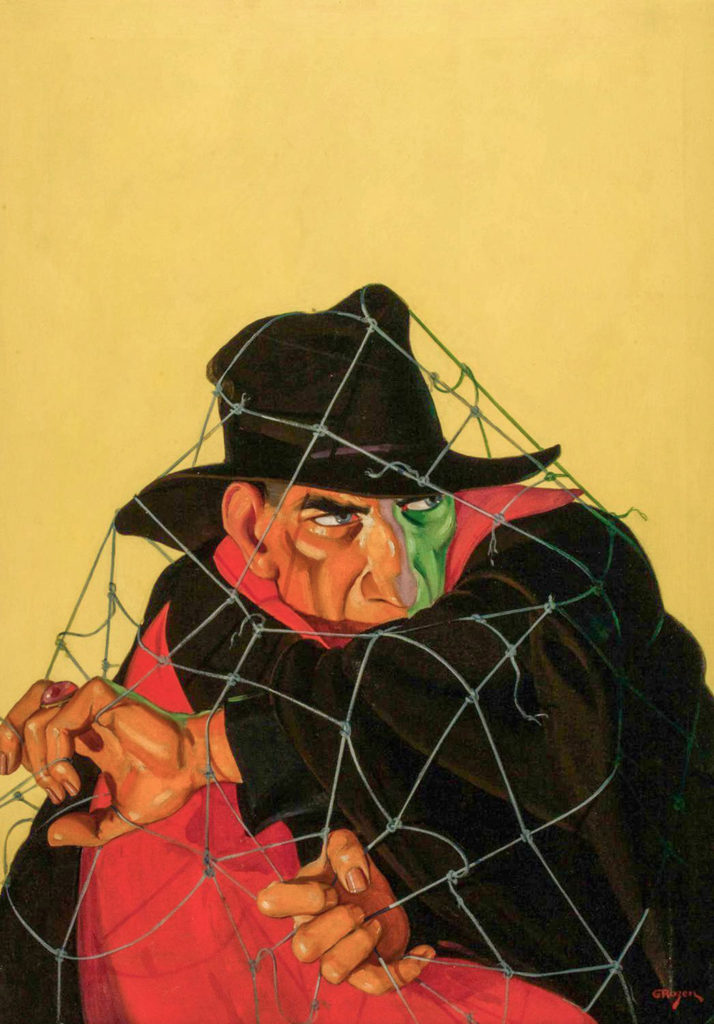
Greene: Which was your first pulp painting?
Lesser: The Shadow: “The Grove of Doom” from September of 1933. I had never seen a pulp painting before though I’d seen pulps. Times were very hard, it was 1972, Jimmy was kind of broke at the time, and I said, “I’m gonna go over and see this guy in Philadelphia, but I ain’t buyin’ diddlysquat.”
I took one look at that painting and I said, “How much?” He said $450, and I gave him a check. I could see the dynamic impact of pulp art. It had to be dynamic impact to sell the magazine. And then after that I got into some others. And the prices were inexpensive: $50, $125, $195.
Greene: $50 for a pulp painting?
Lesser: Yeah, one of the great ones that I bought originally is the one done for Everybody’s Magazine circa 1923-26, by Edgar Franklin Wittmack, of an archaeologist in front of a tomb with his hand on his gun, just like Indiana Jones. That was laying there for $50, I went back, and they raised the price to $85, I bought it for $85. Then for some reason or other I had to trade it to Walker Martin. Years later, I bought it back for $2,000.
Greene: Do you have a personal favorite?
Lesser: Absolutely! The next one. That will be my favorite. Because I haven’t seen it yet. Because I truly believe in the most heretical and sacrilegious fashion, that you can get a spiritual value from material things, and when I get a new painting in, I get a spiritual uplift that is comparable to those that get a religious experience.
Greene: Or an addict with a fix?
Lesser: This is different. It’s not quite that physically destructive. This is a spiritual lift that you get from material things. This applies to the fourth great religion we have on the planet Earth, the most powerful religion besides the big three, and that is materialism. The love of material things and the spiritual value you derive from them. As a religion, I consider myself a “thingist.” I collect things. I get spiritual value from things. And most people are too ashamed to admit this because this is called greed, selfishness, or acquisitiveness, or being of this world instead of the next. And I feel that this religion perhaps more powerful than any of the others.
The great religions of the world couldn’t stop communism. But the commercials from West Germany’s TV crumbled the wall and killed communism in Russia. The people wanted what they saw on the commercials, and they then joined materialism as a religion, and they became thingists.
‘There are at least 2,500 to 3,000 paintings out there’
Greene: How have you found these paintings?
Lesser: You have to understand the ways of collecting anything.
You can wait for them to appear at Sotheby’s and Christie’s and pay super retail. That may take years. If you really want something, you go and hunt it down yourself.
If I were a tiger hunter in Kenya, I’d get up early in the morning and go look for them with a rifle at the water holes. Since there is no real organization to find these paintings, you have to be your own picker, your own hunter, and you have to hunt them down yourself. You have to do the work. So, what I do is I go to Pulpcon; I get leads; I’ve found out who has what, where, and whether they’re willing to part with anything. I have pictures of their collections. Mostly today, they don’t want to sell, but you never know.
So, it’s a continuous effort finding, pressuring, letting people know that this is what you collect. And the continuous education of people as to what pulp art is. It takes them a long time to get it. There are no books, no price guides, and very little information. My feeling is that the best is yet to come.
In talking to Jimmy Steranko, he said that there are at least 50,000 titles (issues). That means 50,000 paintings. If 5 percent were saved, which is not too impossible, that means there are at least 2,500 to 3,000 paintings out there. I’ve found at least 200 to 300 that I don’t have, plus the 117 that I do have. Once the capitalist mechanism gets into motion, and it senses money, the stuff will come out of the attics and cellars, just as animation art did. It will go to Sotheby’s and Christies, and the lust for money will preserve the art. The lust for money will find the art — exhibit the art. And then publishers and museum directors and others engaged in the lust for money will find and preserve this art they have no artistic interest in. It’s ironic.
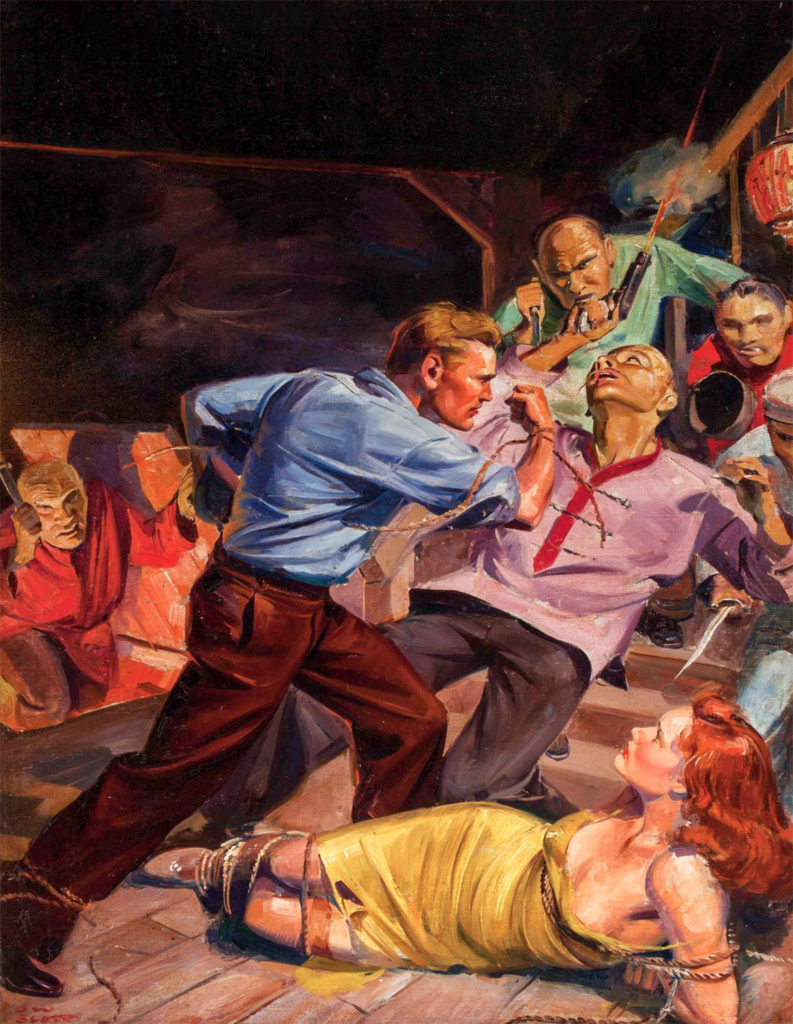
Greene: An interesting dynamic begins to occur. Once people know you’re looking for something, they begin to approach you with things. Everybody knew that Bob Lesser was looking for this, so for quite a while everything “pulp” that turned up was brought to you. But you’re looking for a very specific slice of this genre. You’re looking for the grotesque pulp art. Obviously other pieces that wouldn’t fit in your frame of interest turn up for you. Have you found that this has worked for or against you?
Lesser: Sometimes, this does happen. But basically, I’ve gotten most of my paintings from people who collected them many years ago, who have either tired of them, or need the money, and are willing to sell. This is where most of the supply has been.
Yes, I have found others here and there, people have brought them to me, and they say, “You are the only one who I can sell this to. There isn’t anyone else.” This myth has been created much to my benefit, and I have not done anything to dispel this myth in any way. But it’s really persistence, and what I have found is that other people found these paintings years ago, and saved them. They’ve been laying there, and what I do is I go in and try and separate them from these paintings.
Greene: What’s the most and least you’ve paid for a pulp cover painting?
Lesser: The least is $50 for the Wittmack. I paid $25,000 to Darrell Richardson for Tarzan, Lord of the Jungle painted by J. Allen St. John.
Greene: Why not more interior illustrations? I see a few particularly nice ones, but relatively few in relation to the covers.
Lesser: It’s because I am part savage and I appreciate color. If I had been here when the Dutch bought the island of Manhattan for $24 worth of bright beads, cloth, and trinkets, I would have said, “Take the beads! Take the bright cloth! Take the trinkets!” because I love bright colors. Black — to me — isn’t a color. White is not a color. I don’t even wear white. I have never owned a plain, white shirt. I have some black-and-whites that I like. I’m not completely anti-black-and-white, but basically my concentration is where the concentration was in the 1930s — on the covers. I have an Edd Cartier, I have a Tom Lovell, from The Shadow. Frank R. Pauls, and Virgil Finlays.
‘These paintings come alive’
Greene: Of all the collections you’ve put together over the years, why did you decide to preserve this collection intact?
Lesser: Well, you come down to the Degas question. Degas, the great painter, was having dinner with a bourgeois business man. And the business man said, “M. Degas, I have this. I have that. I have this. I have that.” And Degas asked what has become known as the Degas question, “But, sir, what paintings do you have on the wall?”
There is a gradation of importance in terms of things. And to my mind, the paintings that you have on the wall are perhaps the way that you judge a civilization, an epoch, a time. By the paintings that were created during that time. And the soul of man sometimes comes out into a painting. Like Francis Bacon’s Screaming Pope, his triptychs. Velázquez, with The Servant. These paintings come alive, there is magic — a spiritual value in paintings that has the greatest vector in terms of magnitude and dimensions.
Greene: Do you feel that because the pulp paintings are appearing to or depicting man’s baser instincts, that they are more significant?
Lesser: It’s hard when you think of baser nature. For instance, the best painting in the city of New York, in my mind, is Rembrandt’s self-portrait, one of many, that is hanging at the Fricke Museum. You look at that and you see every kind of disease, every kind of a crisis, every kind of a horror that a man can go through and reach that age that is depicted in that painting.
So, in that sense, it does depict the baser elements of life. But what you call base, I call real, and in Rembrandt’s painting, which is almost analogous to some of these, like The Shadow, you almost see the terror of life. How life kills you before you die, and this is the miracle that you see at that painting at the Fricke and that you see in so many pieces of pulp art.
Greene: You mentioned earlier that you had traded away a painting to another collector, and then purchased it back some years later. Has there ever been one that got away? That you regret passing up?
Lesser: I quote you Nelson Rockefeller. They asked, “Mr. Rockefeller, you’re 70 years old. You have a heart condition. What do you regret about your life?” He replied, “That’s simple! The pieces of art I didn’t purchase because the price was too high.”
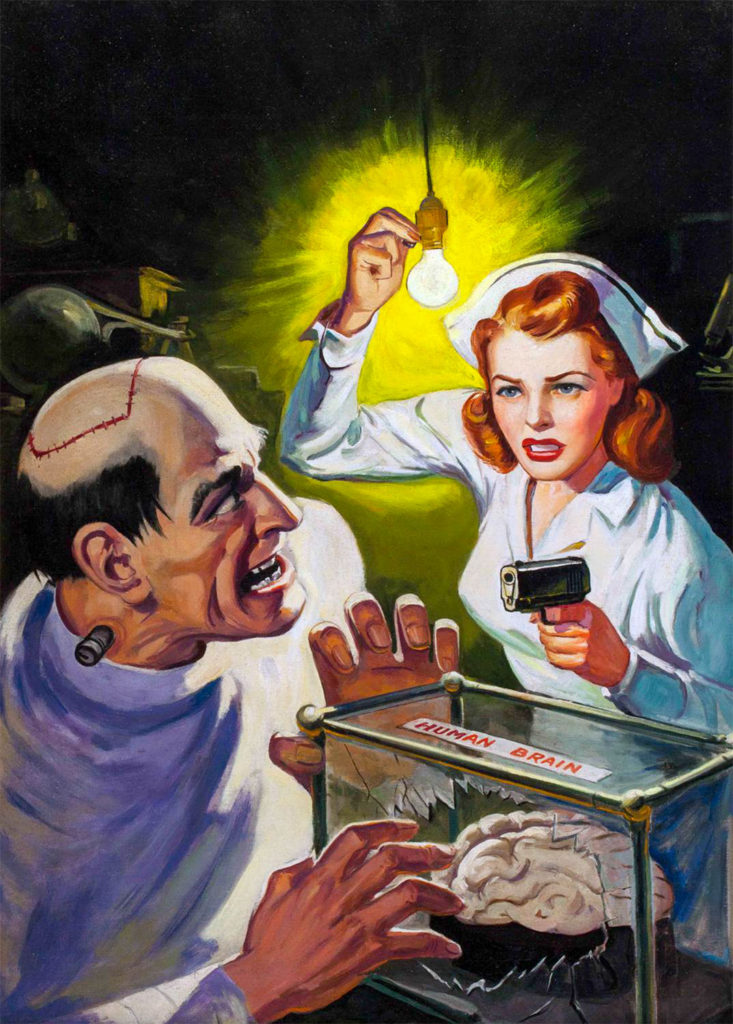
That sums it up for me. But you get into situations, particularly at auctions, where there are no limits. Once the painting gets into the hands of an auction house, it’s too late.
Remember, no collection is ever complete, and some of the best pieces are going to get away. Just look back on your own life. The beautiful women who got away, you’ll remember them for the rest of your life. The same thing applies to art. There’s nothing you can do about it.
Greene: What do you feel is still missing from your collection of pulp cover paintings?
Lesser: I would like to find some by John Newton Howitt; some Strange and Horror covers, and the Operator #5 (covers). I may have one Howitt in that Dime Detective up there where the scientist is trying to get a brain out of a section, and the nurse has a .45 caliber automatic trained on him. I don’t have a really good Margaret Brundage. There’s always more Frank Pauls; there’s a tremendous number of great St. Johns still out there. I’ll tell you when I see it!
Greene: What has been your overall experience with institutions of higher learning and the pulps?
Lesser: I counted 142 pre-WWII pulp paintings when I visited Syracuse University. Syracuse has a tremendous art collection, and I’ve never seen any of it on display. They have all the Hal Foster Prince Valiants. They have a collection of Disney animation cells that I’ve ever seen, including the mirror sequence from Snow White. Surrealistic outlines in the mirror talking. All of Artzybasheff’s Time Magazine covers. A collection of WPA art. I believe Thomas Hart Benton is in there.
You have to understand that people divide into two kinds of people. The book people who live in the world of words, these are the ones who read the pulps. And then there are those who live in the visual world. They don’t read. They go to the movies and look. They go to the pulps and look at the covers and interior art, but don’t read them.
‘A new form of American culture’
[At the time of the interview in 1994, Lesser was planning to bequeath his pulp-art collection to Bowling Green State University. In 2013, he deeded his collection of nearly 200 works, as well as donated $1.3-million for its maintenance, to the New Britain Museum of American Art in Connecticut. – ed.]
Greene: Why Bowling Green?
Lesser: I could give you a lot of highfalutin reasons for it, but they’re the only ones who’ve displayed any enthusiasm for it. I can show you letters from the Museum of Modern Art, Metropolitan Museum of Art, The Guggenheim, and others, who think it quaint. Bowling Green was not prejudiced against popular culture. They have an Island there. And one of the reasons I feel it (the collection) should be there is because this a unique American art form, and it should be planted firmly in the heartland of the country.
Greene: You’ve set up a mechanism in your bequest to perpetuate the collection and continue to acquire pieces.
Lesser: Yes. You’ve seen that little tin toy of Frankenstein, where you put a dime in and a hand comes out and snatches the dime? That’s called the dead hand out of the grave. I’m going to have a dead hand from the grave. They’re going to have enough interest from treasury bonds, which are non-callable — they’ll be getting somewhere between 8- and 9-percent interest so they’ll be able to fund a part-time curator, go to Sotheby’s and Christies — with my money, after I’m dead — and buy more paintings for this collection.
Greene: Walt Disney, who may or may not be frozen in suspended animation, supposedly left plans well into the next century. Do you have a similar program set up?
Lesser: No, because I believe in capitalism and the rational use of money. If they’re as enthused in the future as now, and with their education and dedication to popular culture, they won’t need me. Just the money. Ergo, Capitalism!
Greene: What will future generations find in these paintings?
Lesser: American Genius. A new form of American culture. You have to realize that this country is different from Europe in one respect. It’s written in the Constitution. We do not have kings or queens, princes or princesses. The function of the nobility is largely as arbiters of taste. You must go to the opera — the ballet — the theater; movies are, as Ben Hecht put it, “an eruption of trash that has lamed the American mind.”
The major effect of all of this, is that there is nobody to tell you what to do in the United States of America. We have cultural anarchy, thank God, and I personally propose that the national anthem be changed to Cole Porter’s Anything Goes! I jog to Madonna’s Material Girl!
Greene: What should your epitaph be?
Lesser: Simple. “He’s gone to the movies.” My major love is still the movies. That’s it!
Copyright 2021 Richard Greene. Republished by permission.
About the author
Richard Greene is an independent graphic designer and marketing consultant. A compulsive collector since childhood, he has focused primarily on pop-culture art and publications for the past 45 years. His most recent commercial work has been for Gryphon Books‘ Paperback Parade: The Magazine for Paperback Readers & Collectors, and DeVito Artworks‘ King Kong of Skull Island.


